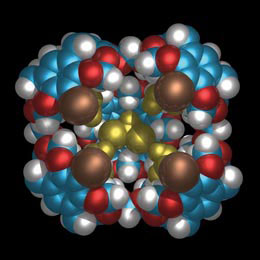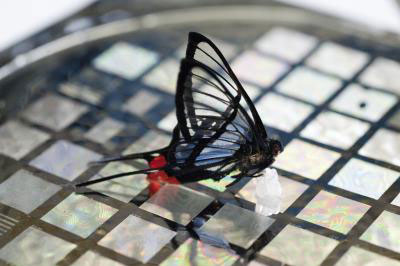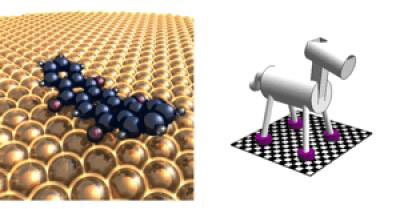New microfluidic chip for discriminating bacteria
A new 'on-chip' method for sorting and identifying bacteria has been created by biomedical engineers at Taiwan's National Cheng Kung University.
Sep 14th, 2010
Read more
A new 'on-chip' method for sorting and identifying bacteria has been created by biomedical engineers at Taiwan's National Cheng Kung University.
Sep 14th, 2010
Read moreNew manufacturing approach may lower solar energy costs.
Sep 14th, 2010
Read moreSemiconductor Research Corporation (SRC), a leading university-research consortium for semiconductors and related technologies, today announced the top professors in chip research for 2010.
Sep 14th, 2010
Read moreAward to be presented at the Grove Fuel Cell Science + Technology Conference; Zaragoza, Spain, 6-7 October 2010.
Sep 14th, 2010
Read moreDelft University of Technology officially opens a new Department of Bionanoscience on Thursday 16 September. The new department will focus on virtually unexplored scientific terrain: the interface between biology and nanoscience.
Sep 14th, 2010
Read more Scientists from Australian National University have developed a 'Superbowl' drug delivery system that promises more accurate doses of drugs with fewer side effects.
Scientists from Australian National University have developed a 'Superbowl' drug delivery system that promises more accurate doses of drugs with fewer side effects.
Sep 14th, 2010
Read moreArizona State University's expanding research, education and entrepreneurial endeavors in photonics engineering and science has led to formation of the Center for Photonics Innovation.
Sep 14th, 2010
Read moreResearchers from Europe and China warn that little can be done to stop dangerous increases in the global sea level, as it will rise between 30 to 70 centimetres (cm) by 2100 even if all but the most aggressive geo-engineering schemes are undertaken to mitigate the effects of global warming and stringently control greenhouse gas emissions.
Sep 14th, 2010
Read moreTo highlight breakthroughs in this area, the editors of Energy Express, a bi-monthly supplement to Optics Express, the open-access journal of the Optical Society, today published a special Focus Issue on thin-film photovoltaic materials and devices.
Sep 13th, 2010
Read moreAn international all-star lineup of experts in solar and biofuel energy, climate science, urban design and other areas of research critical to sustainable energy technologies will gather in Berkeley for a public symposium on October 1 and 2, 2010.
Sep 13th, 2010
Read more The light, tickling tread of a pesky fly landing on your face may strike most of us as one of the most aggravating of life's small annoyances. But for scientists working to develop pressure sensors for artificial skin for use on prosthetic limbs or robots, skin sensitive enough to feel the tickle of fly feet would be a huge advance. Now Stanford researchers have built such a sensor.
The light, tickling tread of a pesky fly landing on your face may strike most of us as one of the most aggravating of life's small annoyances. But for scientists working to develop pressure sensors for artificial skin for use on prosthetic limbs or robots, skin sensitive enough to feel the tickle of fly feet would be a huge advance. Now Stanford researchers have built such a sensor.
Sep 13th, 2010
Read more UC Riverside chemists study quadrupedal molecular machines to provide an answer.
UC Riverside chemists study quadrupedal molecular machines to provide an answer.
Sep 13th, 2010
Read more The Tech Museum today raised the curtain on its most ambitious exhibition, The Tech Silicon Valley Innovation Gallery, revealing cutting-edge technology developed by the world's foremost experts on computing, digital design, communication and collaboration. The nearly 3,000-square-foot gallery captures the spirit of Silicon Valley ingenuity, examining the core of innovation -- the microchip -- and immersing visitors in the exciting world of nanotechnology, digital art and mapping.
The Tech Museum today raised the curtain on its most ambitious exhibition, The Tech Silicon Valley Innovation Gallery, revealing cutting-edge technology developed by the world's foremost experts on computing, digital design, communication and collaboration. The nearly 3,000-square-foot gallery captures the spirit of Silicon Valley ingenuity, examining the core of innovation -- the microchip -- and immersing visitors in the exciting world of nanotechnology, digital art and mapping.
Sep 13th, 2010
Read moreSensitive, yet tough. That's nanoDESI. The nanospray Desorption ElectroSpray Ionization technique analyzes tiny samples of atmospheric aerosols.
Sep 13th, 2010
Read moreCANEUS International will be holding CANEUS 2010 Workshops as part of the International Week on Micro and Nano Technologies (MNT) for Space 2010. The event is being held at the ESTEC-ESA Centre in The Netherlands the 13-17 September 2010.
Sep 13th, 2010
Read moreThe NSF funded project titled, 'Collaborative Research: New Graph Theory from and for Nanoconstruct Design Strategies', focuses on using mathematics and computers to design nanoconstructs to carry out practical jobs in the future.
Sep 13th, 2010
Read more